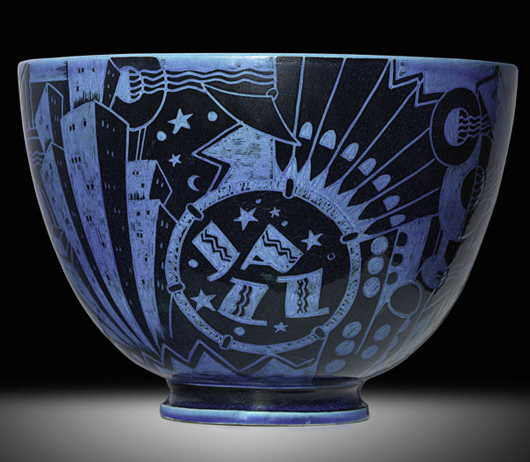
LAMBERTVILLE, N.J. – One of the few original Jazz Bowls extant will be sold in Rago’s June 17 auction of Modern and Contemporary design. Signed by Schreckengost and stamped Cowan, the large bowl carries an estimate of $40,000-$60,000.
“This could be the last of the original Jazz Bowls in private hands,” said David Rago.
LiveAuctioneers.com will provide Internet live bidding for the two-day auction.
The first Jazz Bowl was commissioned by Eleanor Roosevelt in celebration of her husband’s reelection as governor of New York in 1931. Ceramicist Viktor Schreckengost was only in his mid-20s when he created it, a worker at Cowan Pottery in Rocky River, Ohio, and the youngest faculty member at the Cleveland Institute of Art.
A saxophonist as well as an artist, Schreckengost saw jazz as the perfect expression of the New York City’s excitement and drive. He caught its spirit in three-dimensions: tilting skyscrapers, Radio City Music Hall, the Cotton Club, cocktails, signage, stars, a drum head with the word “Jazz.”
He built it large, in a simple shape he called “parabolic.” To evoke the light of a New York night, he covered the bowl with black engobe (watery clay mixed with glaze), scratched his design in a pattern of black and white, fired it, covered it with a glaze he called Egyptian Blue, and fired it again.
Mrs. Roosevelt was so taken with the bowl that she commissioned two more. Immediately after, a New York City gallery placed an order for approximately 50. The handcraft was arduous, taking Cowan’s artisans an entire day to incise one bowl. A second version was made with a flared lip and then a third. The third version, known today as “the poor man’s Jazz Bowl,” was a production line. It is slightly smaller than the original, with a flared lip and raised, not sgrafitto, decoration. Bowls with other themes were also designed, as well as decorative plates.
The Jazz Bowls were something less than a footnote in the history of design until the mid-1980s. With the resurgence of appreciation for Art Deco, the bowls began to be featured in museum exhibitions. Within a decade, the Jazz Series was widely recognized as an icon of American design. The highest selling price to date is from a Sotheby’s auction in December 2002, when a bowl of equal size from a private collection sold for $254,400.
No one knows with certainty how many hand-incised Jazz Bowls were made before Cowan folded at the end of 1931. Estimates range from 20 to 50. Fewer than 20 are known, and which of these were made for Eleanor Roosevelt seems to be something of a mystery. The one to be sold at Rago’s in June is the latest to emerge. It may be the last.
The auction will begin at noon Saturday, June 16, with Early 20th Century Design and continue at noon Sunday, June 17, with Modern/Contemporary Design.
Previews will be at Rago Arts and Auction Center from Saturday, June 9, though Thursday, June 13, from noon to 5 p.m., Friday, June 15, noon to 7 p.m. and by appointment. Doors open at 9 a.m. the days of the sale.
For details visit www.ragoarts.com or phone 609-397-9374.
ADDITIONAL IMAGE OF NOTE



